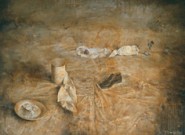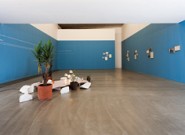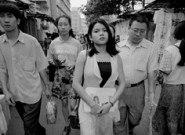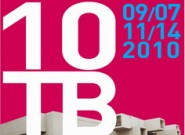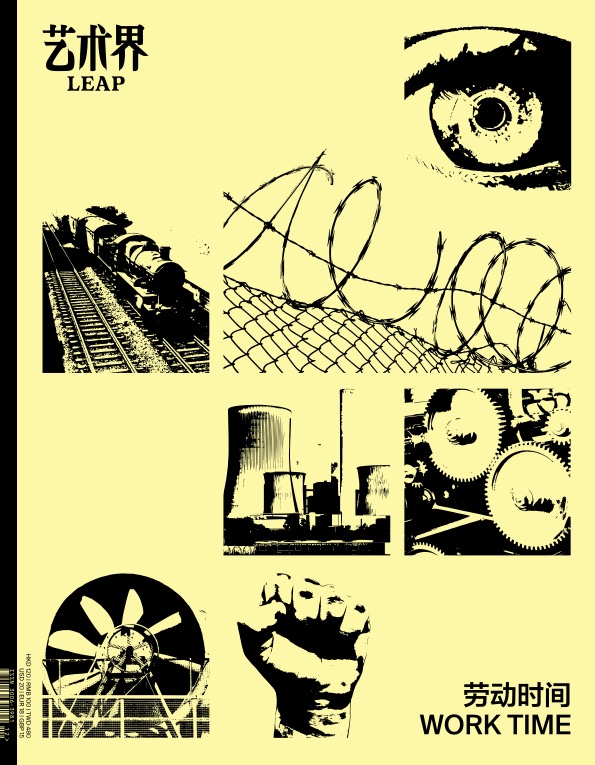The telling and re-telling of fables, tall tales, and mythologies can conjure visions at once delightful and terrifying. Too often the fantastic becomes grotesque, the mystical monstrous, and the everyday surreal. Wu Junyong’s recent show dips into the horrible pleasures of the misread idiom, deploying image-symbols of downtrodden clowns, cranes, textless books, flutes, and pointed…
Read MoreIn “The Seduction of Village” some new ideas arise that are worthy of attention. Due to Duan Jianyu’s bias towards text and narration, general commentary may liken her work to contemporary rhetoric—which, in some respects, it embodies. In one narrative series, Duan depicts a village woman nursing—a simple image that reappears before three separate backgrounds:…
Read MoreAt once meticulous and good-humored, David Diao’s twelve boldly colored canvases on view in Antwerp presented a succinct midcareer synopsis, bookended by references to the American painter Robert Motherwell. The works on view date from 1986 through 2010, beginning with two excerpts from Diao’s mid-1980s “Little Suprematist Prisons” series, whose hard-edged geometric compositions stage an…
Read MoreChen Wenji’s solo exhibition, held by the Central Academy of Fine Arts, is divided into two parts; the main gallery features his most recent work, while the secondary space displays his early works. It is clear that the curator chose this layout in order to linearly showcase the evolution of Chen Wenji’s comprehensive body of…
Read MoreNadim Abbas, in his first complete solo exhibition, brilliantly composes a scene that so resists interpretation that the viewer defaults into passive observation, submitting to a flaccid presentation of spectacle in the absence of any plausible guiding narrative. Several of the artist’s earlier projects fall into the category of conceptual assemblage, consisting of fragments of…
Read MoreLiu Chuang is skilled at unearthing what is hidden beneath the surface of life’s quotidian systems. In doing so, he unmasks these systems as an apparatus that controls the perception of time, ensures the production of history, and protects the perpetuation of the species. And the moment they are questioned or doubted, their institutionalized essence…
Read MoreThe first iteration of “Liu Ding’s Store” was conceived in the project “Take Home and Create Whatever Is the Priceless Image in Your Heart,” exhibited in 2008 at the Arnolfini gallery in Bristol, England. Liu Ding commissioned artists from the Dafen oil painting village outside Shenzhen to recreate a floating visual motif on a blank…
Read MoreRemember when you were a little kid and you’d take out all your toys and create fantastic stories about their relationships, pitting them against each other in epic battles? Chen Wenling certainly does. His recent exhibition is a highly emotional narrative on themes of conflict and domination, rich (as titularly promised) with the suspension of…
Read MoreArtists organizing events around the disparate interests of people outside the art world proper can lead to some fascinating convergences of concerns. (Of course, a deft hand is needed to satisfy the demands of such varied constituencies.) Emi Uemura’s “Country Fair,” initiated last year in Beijing with Vitamin Creative Space, is a successful example. A…
Read More“One Project. Two Sites.” Curator Josef Ng warned viewers at the start that Lin Yilin’s project, carried out in Chiang Mai and Bangkok, would present two utterly different sides of itself. And in the end, he was right. In the Chiang Mai countryside, Lin Yilin highlights the utopian connotations of the “Land Project,” guiding his…
Read MoreThe 2008 Guangzhou Triennial’s “Farewell to Post-Colonialism” initiated discourse on a potential conclusion to the post-colonial epoch. “Days of Our Lives,” Wong Hoy Cheong’s solo exhibition at Taipei Eslite Gallery, was thus a kind of farewell ceremony, yet one with a strong sense of irony. In the video work Dog Hole (2010), Wong Hoy Cheong…
Read MoreStarting with its title, Bulgarian artist Nedko Solakov’s recent outing at Continua bespoke a dubious ambivalence toward a bygone system. Spread across the entire two-floor space, Solakov’s noncommittal stance is effectively revealed in the wide range of media presented— video, painting, graffiti, and writing—through which the artist filters his convoluted if honest ideas about art…
Read MoreZhang Xiaogang and Mao Xuhui have been close friends since they were first acquainted in Yunnan in the late 1970s. Early on, their artistic practices and trajectories in life overlapped considerably. Around the time of the ’85 New Wave, the “New Figurative Art” exhibition was born, and later the “Southwest Art Group.” Even after Zhang’s…
Read MoreAs curator of one of the world’s premier collections of classical Chinese art outside of China, Hao Sheng’s responsibility is to explain a visual culture that, more often than not, alienates its viewers. Sheng recently invited ten artists to make contemporary responses to works from the permanent collection of the Museum of Fine Arts Boston….
Read MoreAs with most large-scale periodic exhibitions, in Lianzhou we find two festivals—the official show that unfolds in more formally curated gallery spaces, and a parallel program happening beyond that, including a range of events taking place in the small town itself. The latter “festival” can easily escape the public eye—a dead zone full of heretofore…
Read MoreCarrying on a tradition established in its previous edition, the 2010 Taipei Biennial does not have a set exhibition title. This does not mean, however, that it does not have a theme. In the exhibition text, “Curatorial Discourse,” featured curators Tirdad Zolghadr (1973-) and Hongjohn Lin (1964-) call attention to two issues that are central…
Read MoreIf liberal-mindedness was the legacy of the groundbreaking edition of the Shanghai Biennale titled “Shanghai Spirit” in 2000, then in 2010, “Rehearsal” represents a tentative step in the direction of reflexivity. Though the word “Rehearsal” does not connote much on its own, we can extract from a reading of the exhibition’s expository texts a posture…
Read MoreZeng Fanzhi’s exhibition of paintings and sculptures at the Rockbund Art Museum in Shanghai (curated by Wu Hung) fills the building’s three stories as well as a nearby church. On a wall of the museum’s ground floor hangs a ripe, oozingly gorgeous oil-on-linen painting of a slaughtered lamb carcass, a fresh reminder of the artist’s…
Read MoreZeng Hao’s solo exhibition, “Summer,” is touching to behold; in this collection of works, we see how an artist, after two decades of searching, has at last returned to the pure depths of his heart. A painting that depicts personal experience is not an uncommon phenomenon. But a painting that combines personal experience with the…
Read MoreLiu Xiaodong first came to the town of Yanguan in the northwestern province of Gansu in the fall of 2008 to paint the horses for which it is famous. Captivated by this diverse locale, he returned a year later to make portraits of its citizens, a project that soon became a cross-cultural comparison between a…
Read More



